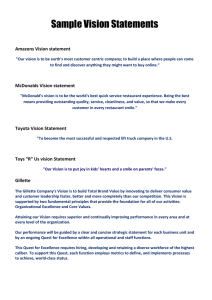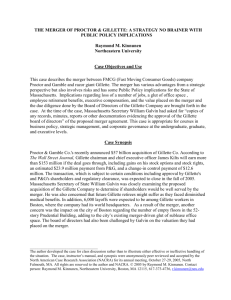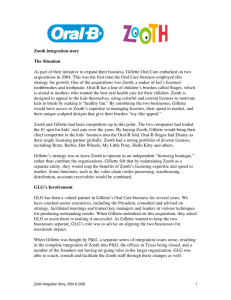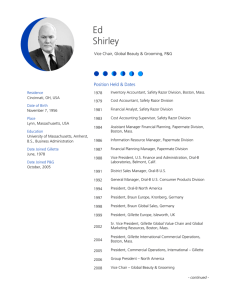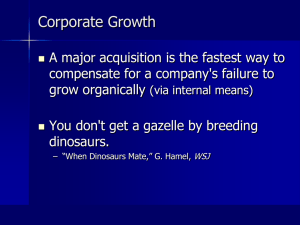Gillette, established in 1926, has recently become part of Procter
advertisement
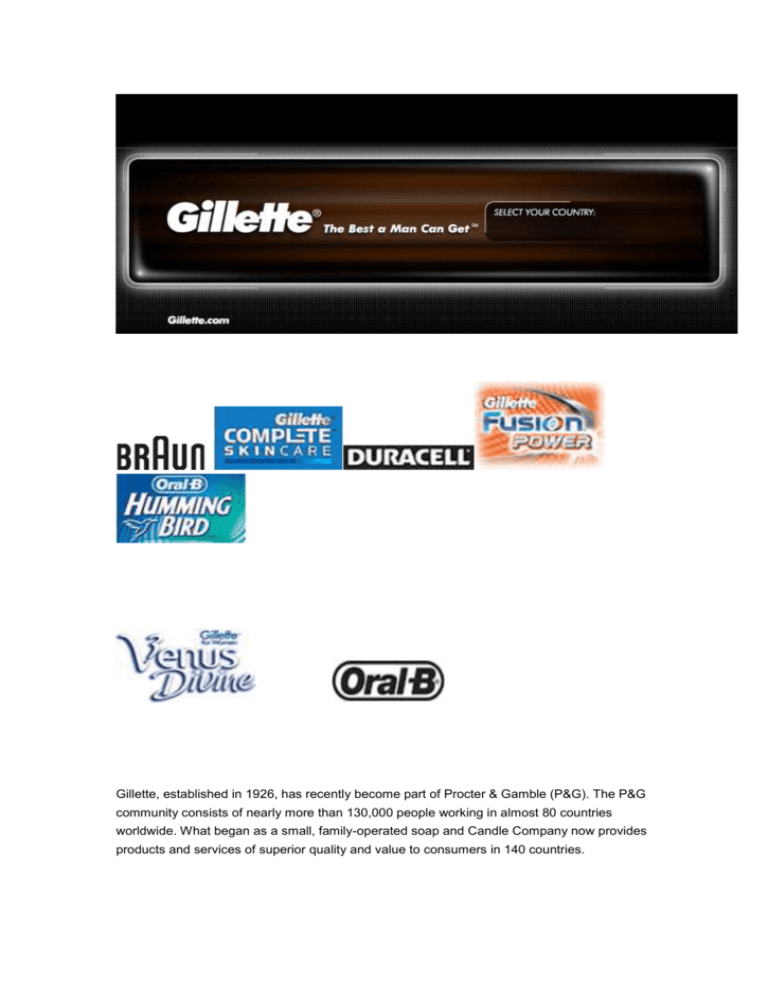
Gillette, established in 1926, has recently become part of Procter & Gamble (P&G). The P&G community consists of nearly more than 130,000 people working in almost 80 countries worldwide. What began as a small, family-operated soap and Candle Company now provides products and services of superior quality and value to consumers in 140 countries. Logistic facts: 4 DC’s (Distribution Centers) in the United States. Re-engineering increased manufacturing forecast accuracy from 46 to 71 percent and lowered inventory some 24 percent in two years. How Gillette concentrates on the customer. Two years ago, Boston-based Gillette Co. re-engineered its international processes and organizational structure to focus on bringing value to its customers. “We oriented ourselves around the “value chain” that starts and ends with the product on the shelf”, says Mike Duffy, Gillette’s vice president, North America Value Chain. Most companies subscribe to a conventional view of the supply chain, Duffy believes. Gillette has taken an alternate route. “The supply chain historically is depicted on a chart as a process that moves from left to right, from supplier to the factory to the DC (Distribution Center) to the customer’s DC to the store”, he explains. “With the value chain concept, we’re sending the message to our organization that we’re not just about supplying the customer with product. We’re about bringing value to the customer and ultimately to the consumer”. Early indications are that the process and organizational changes have not only brought value to the customer, but have also generated positive results for Gillette. Since the re-engineering took place, the company has witnessed a 24 percent reduction in inventory even as it boosted customer service levels. More importantly, Duffy says, Gillette has improved product visibility in its supply chain, a move that allows the company to make smarter tradeoffs between inventory and customer service. Data rich, Information poor. Gillette sells more than facial care products. The consumer products giant also owns such brands as Braun appliances, Right Guard deodorant, and Duracell batteries, which it markets through leading retail and grocery chains. Worldwide sales revenue last year exceeded $ 8 billion. Although Gillette had long been a leader in the personal care market, executives believed the company’s performance had fallen behind that of competitors like Colgate and Unilever. In 2002, spurred by CEO James Kilt’s “functional excellence” initiative, Gillette conducted a benchmarking survey that compared its operations against those of its industry rivals. The results showed that inventories were high and service levels were low. “We found we had high inventory levels as compared to our peers”, Duffy says. “We also performed poorer in customer-service measures. It was a kind of paradox, because if you have high inventory, you usually use it to keep a high customer service level. To identify the sources of those problems, Gillette began a six-month project to analyze its supply chain processes. “We mapped it out on white boards”, Duffy recalls. “Some of it was painful because we had a lot of processes to analyze. That analysis found a number of areas for improvement. High on the list was the lack of synchronization between planning and execution. Gillette often had the right inventory, but it wasn’t in the right place because data was not synchronized throughout the company. “The cycles for supply and demand planning we off”, Duffy says. “We had gaps across the process interfaces that contributed to high inventory and poor service”. For example, demand planners usually finished their forecasts for the coming month during the third week of the current month. Production schedules, however, often were set during the second week of the month. Because of that arrangement, if a forecast changed, it often would be too late to make changes in production. Similar problems arose because definitions were not aligned across different functions. For instance, inventory planners relied on standard cycle times for replenishing warehouses from certain factories. When planners asked for inventory to be deployed, they expected it to arrive within those parameters. Distribution, however, measured on-time performance according to how long a shipment was on the road – i.e., whether or not the actual transit time fell within allowable limits. “This disconnect often led to product arriving at the DC late”, Duffy says. The project team also found that there were many unnecessary complexities in the supply chain and that Gillette held a large number of underperforming stock-keeping units (SKU’s), which resulted in unsold products piling up in warehouses. The mapping process further made it clear that the company needed to engage in more flexible manufacturing, including assembly postponement, in order to better respond to market changes. Strategies for Success If there was a single, overarching message that came out of the process-mapping exercise, it was that Gillette had to improve both its demand-and supply-planning processes while streamlining its supply chain. Duffy and his colleagues used several strategies to achieve those objectives. For instance, Gillette now breaks down demand planning information into components such as key accounts, special promotions and club-store purchases. In addition, the company builds demand forecasts from the “bottom up”, collaborating with its customers to determine future product needs. As for supply planning, Gillette shortened the order-to-delivery period for shipments to both distribution centres and to its customers. The manufacturer also began to employ statistical models to set inventory parameters. In the past, it had relied on inventory planners to decide stock levels using a spreadsheet tool that had been developed in-house. Now, Gillette uses software from Optiant that examines a number of variables to determine the appropriate level of inventory. Some of those variables include weekly order history and variability, forecast accuracy, frequency of product runs, and lead times required to replenish the distribution centers. Although Gillette wanted to change the way it analyzed its operations, it didn’t need to buy new software to do that. Instead, supply chain managers took better advantage of the Manugistics planning application they already had. “Part of what we found in the analysis process was that we didn’t give our end users appropriate training with the system”, Duffy says. “We had to do a lot of retraining”. Once Gillette was ready to make process changes, the company made the requisite organizational changes to support them. In the past, demand planning, supply planning, promotion management, and distribution each had its own vice president who reported to the Chief Executive Officer (CEO). Those functions now report to Duffy, giving him visibility and control across the supply chain and allowing him to weigh the value of tradeoffs between inventory, cost and customer service. As part of that reorganization, the company also realigned managers’ objectives and incentives so that they supported the value-chain concept. “Before, people with individual objectives would make a decision based on their objectives, without an appreciation of the whole system”, says Duffy. “One of the things we were able to do is bring the organization together.” Also crucial to the program’s success was the adoption of a new attitude. “The mindset is that the value chain starts and ends at the shelf,” Duffy explains. “It’s not just focusing on supplying the customers’ DC, but also on how do we partner with our customers so we can make sure that the product gets to the shelf at the right time and at the right cost for the consumer. “We want to make sure we understand how the customer’s supply chain works and how our products move.” Recognized for Excellence Gillette’s supply chain transformation has produced several big improvements. The accuracy rate of manufacturing forecasts at the distribution-center level soared from 46 percent to 71 percent. At the same time, the company has eliminated 7 percent of its SKUs (Sales Keeping Units) by dropping products that did not meet financial targets. In addition, it has reduced the number of SKUs that are specific to the Canadian market by adopting North American packaging in some cases. Gillette also cut the number of ship-to locations by 30 percent. “It may not sound like much, but when you do it year over year, every little bit helps”, Duffy says. Taken together, those steps have resulted in major inventory reductions. In the second quarter of 2002, Gillette had 126 days worth of inventory on hand. In the second quarter of 2003, it had 115 days’ worth of inventory. During that same time period, Duffy notes, customer-service levels – measured as fill rates on orders – rose from 90 per cent to 98 percent. What’s more, inventory levels are down 24 percent since the project began. Despite gaining better supply chain visibility, Gillette still finds it a challenge to determine its true costs and make appropriate tradeoffs. “Everybody needs to understand cost-to-serve – to understand the true customer profitability”, Duffy explains. “We’re trying to understand where we have opportunities to streamline and become more efficient.” Meanwhile, word has spread about Gillette’s accomplishments. Recently, the Voluntary Interindustry Commerce Standards (VICS) group gave the company its Collaborative Commerce Achievement Award for its work with one of its big customers. But Gillette doesn’t plan to rest on its laurels. Instead, Duffy says, he plans to replace the current performance metrics with more challenging objectives. “We’re always focusing on continuous improvement, and we can do so by changing to a harder measure”, he says. “When we get good at first-time fill rate or on-time delivery, we’ll employ the harder measure, which is on-time-complete. As we get better at on-time complete and data synchronization gets better, we can move on to the perfect order. You have to continue to push the organization and say here’s our stretch goal this year, but once we hit that measure, recognize that we’ll move on to another measure. That’s the only way to institutionalize continuous improvement”. Assignment 1 Analyze the major Logistic problems of the Gillette Co. prior to the start of the improvement project Assignment 2 Gillette has improved their Logistics Efficiency in many ways. Analyze some of these examples from the text and by using relevant theories you are requested to explain how each of them contributes both to the improvement of Gillette’s competitiveness and to the company’s profit making. Assignment 3 Describe the organizational changes and their purpose that took place when Gillette was ready to make process changes. Assignment 4 State the difference between the Value chain and the Supply chain.
